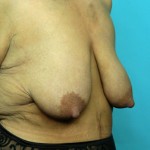
Understanding breast ptosis and how to classify it is important for all patients to understand, because the degree of breast ptosis determines the appropriate plastic surgery treatment. Does the breast need a lift, a breast implant or both? If it needs a breast lift, what type of breast lift….vertical or extended? These type of treatment decisions are guided completely by whether breast ptosis exists and , if so, to what degree?
Breast ptosis is defined by where the nipple sits relative to the lower breast crease or inframammary fold. (where the underside of the breast meets the rib cage) In a normal youthful breast, the nipple and the entire breast mound sit above the lower breast crease. Breast ptosis occurs in four degrees of severity as follows; 1st degree (the nipple sits at the level of the fold), 2nd degree (the nipple sits below the fold but some breast tissue is still below the nipple, 3rd degree (the nipple sits below the fold and at the bottom of the breast), and pseudoptosis. (the nipple is above the fold but most of the breast sits below the fold)
Knowing the degree of breast ptosis determines breast reshaping options. For 1st degree ptosis, a breast implant alone or in conjunction with a small breast lift will work well. For 2nd and 3rd degree ptosis, vertical and extended breast lifts with implants for volume are needed. The lower the nipple sits, the greater the amount of breast lifting that is needed. Breast implants can never lift a nipple that is too low, that is what breast lifts do.
Dr, Barry Eppley
Indianapolis, Indiana


